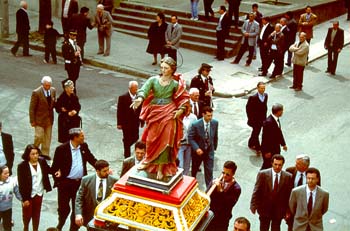Places of interest
Church "Chiesa del Rosario": The foundation-stone was layed by Don M. Siciliani on 7 May 1823. It is in baroque stile and under monumental protection (law 1089/39). Very beautiful are the fresco by Colloca and Brunetto Aloi and some wooden statues.
Church "Chiesa Matrice": Built during the XVII century. Very interesting are the beautiful wooden statues of the patron San Girolamo and of the Risen Christ by Domenico de Lorenzo. Furthermore there are the wooden statues the "Varette", made between 1821 and 1893 by the sculptor F. Biangardi, which rappresent the stages of the Passion of Christ. At Easter these statues are exposed in the church and on Good Friday they are used in a procession.
Church "Chiesa dei Santi Cosma e Damiano": Built during the 8th century as a small wooden chapel, dedicated to the Madonna delle Grazie and to St. Cosma and Damiano, was rebuilt during the first half of the 9th century into the present shape.
Church "Chiesa della madonna della Catena": Built between 1854 and 1860 by Don Luzio, on the ruins of the church of St. Maria di Campoforano, built during the 8th century and distroyed during the earthquake in 1783.
Church "Chiesa di San Giuseppe": Built in 1865 by the artisans and carpenters of Cittanova on the ruins of the Chiesa di San Francesco di Paola which has been destroyed during the earthquake of 1783. Very interesting are the wooden statues of Biangare and rappresent St. Josef with the child.
Fountain "dell'Olmo" - 1730 - At the beginning it was posed in front of the courtyard of the Chiesa Madre, but after the earthquake of 1783 which let this fountain intact, it was transfered to the pubblic gardens and 1932 to it's present location.

The Civil Museum of Natural History: It was inaugurated on 29 July 1996 and soon it became an important cultural destination of a continuously growing number of visitors. The finds, skillfully restored with the modern tassidermia-tecnic, take part of a big historical collection also from the last century. Very interesting are the geological/petrographical and mineralogical departments, were you can see many samples of magmatic, metamorphic, sedimentary rocks, some of which are originated from the Aspromonte. In the botanical department you can see examples of lichen, musk, ferns, gymnosperm and angiosperm. Also the zoological department is very interesting. There is a rich collection of enemic vertebrates of South-Italy and of other european and non-european countries. Worth a visit is also the paleontologic department with a very rich collection of animal and vegetal organism coming from Europe and non-european countries and a collection of very ancient stromatolitic seaweed.
Website by Ferdinando Milicia - photos by Ulrike
Schmidleithner
All rights reserved - 1999 - 2000
|